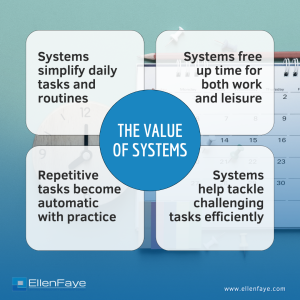01 Oct How To Stop Reinventing the Wheel
Some people love systems, while others resist them. Have you ever asked yourself why you have a system in place? We utilize them so we don’t have to reinvent the wheel every single day.
Most people strive for efficiency. This helps clear time for the tasks that need to be done, while still leaving room for the things we want to do. A useful tool for increasing our efficiency is a well-designed system.
What do you have a system for?
- Getting ready for bed
- Getting dressed in the morning
- Paying bills
- Establishing children’s bedtimes
These everyday tasks involve numerous steps, yet we perform them so frequently that they become routine. Initially, we need to think through the process, but after repeating it enough times, it becomes automatic. This is the process of learning and integrating new systems and methods.
What systems would be beneficial for you to develop, practice, and execute often enough to become second nature? Here are a few of my favorites:
Planning Today’s Work
- I review my calendar, check my emails for anything new, and look at my task list for high-priority items. Then, I assess how much time I have available for work.
- Based on this, I determine my tasks for the day. Sometimes I jot them down on a sticky note; other times, I work directly from my task list. It’s perfectly fine if it varies from day to day.
- What helps me the most is having a curated list of priorities to focus on each day. I strive to include only the work I can realistically complete. On days when I do this, I am often amazed by how much I accomplish.
New Client Onboarding
- I open my master Getting Started document and customize it with the specific needs of the client. I then save the document with the client’s name.
- Next, I open an email and use a pre-written template saved in my signature. I update the email with the client’s name, start dates, and materials needed, and add a personalized greeting. I attach the Getting Started document.
- I enter the client’s email address, hit send, and I’m done! This entire process takes just five minutes. I’m a bit embarrassed to share how quickly I can do this—I want my clients to feel special. Most of the time, the effort lies in the personalization.
Weekly Meal Planning
- I keep a running grocery list. Whenever I use an item up or get close to finishing it, I add it to the list.
- Before heading to the store (or ordering groceries), I plan what I’ll cook or eat for the week.
- My breakfasts tend to be repetitive. As long as I have eggs, fruit, and the ingredients for oatmeal and granola, I’m set.
- For lunch, I prefer leftovers from the previous night’s dinner. I also keep tuna fish packets, salad ingredients, and sliced turkey breast on hand—this is usually all I need.
- I enjoy cooking dinner a few nights a week as it helps me make healthier choices and serves as a great creative outlet. First, I look at my calendar to determine how many nights I can realistically cook. Then, I select recipes accordingly—usually around three. I try not to overdo it to avoid wasting food. I browse my collection of recipes (which I often change) saved in a three-ring binder or flagged in a favorite cookbook and write down the necessary ingredients on my grocery list. If an item isn’t available, I can figure out a substitute on the spot.
- I cook! Knowing I have ingredients for a few different meals gives me the flexibility to whip up whatever I’m in the mood for. However, I make it a priority to prepare fresh fish the same day I buy it.
From these examples, you can see that developing a system can apply to nearly anything. I bet you have numerous systems in your life that you don’t even realize.
Stop Reinventing the Wheel Consider applying this approach to the areas that challenge you. Can you identify one task that frustrates you and that you struggle to complete? Do you have a system for it? Probably not. Can you create one? Likely. If you’re having difficulty, please comment below, and I’ll be happy to share some ideas to help you get started.
Coming Soon to Audible: Productivity for How You’re Wired, print, ebook, and soon as an audio book, available on Amazon.




No Comments